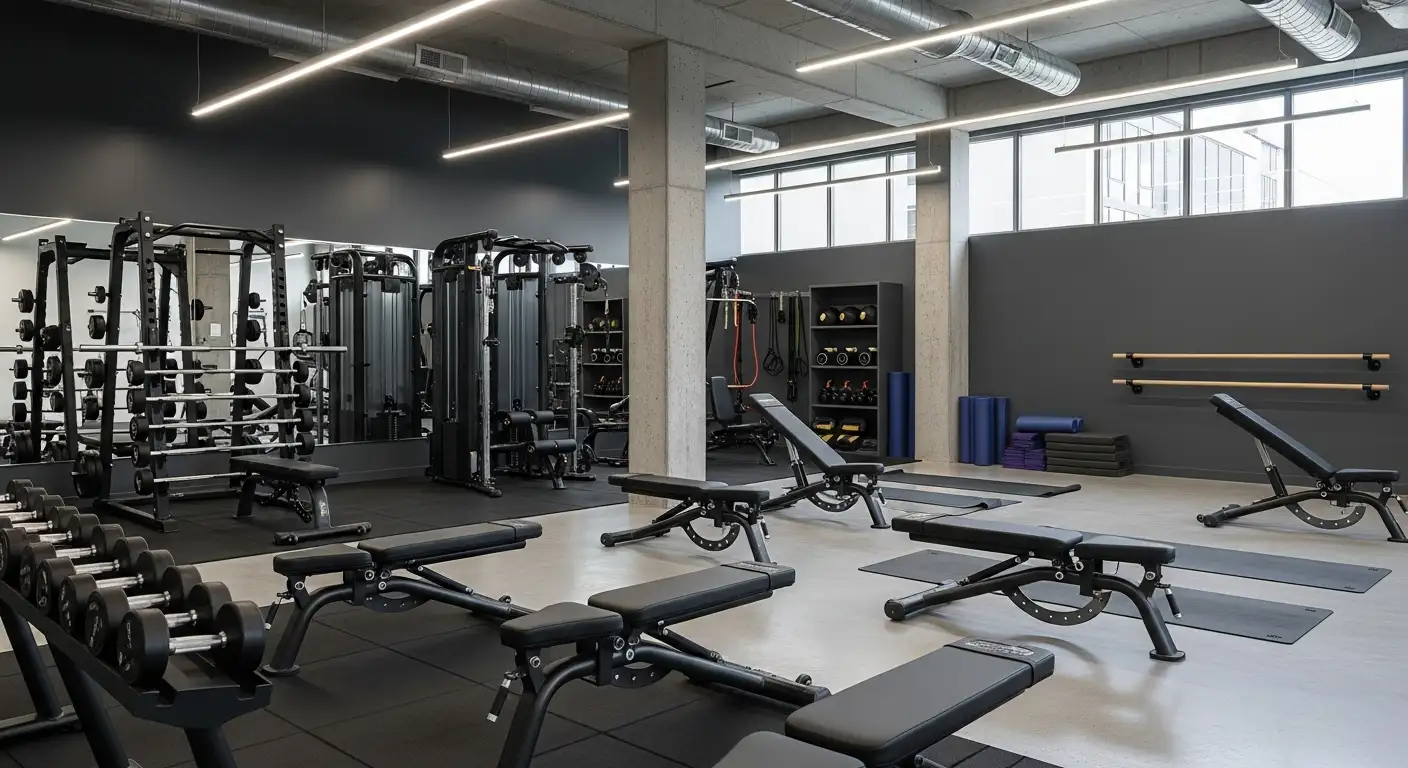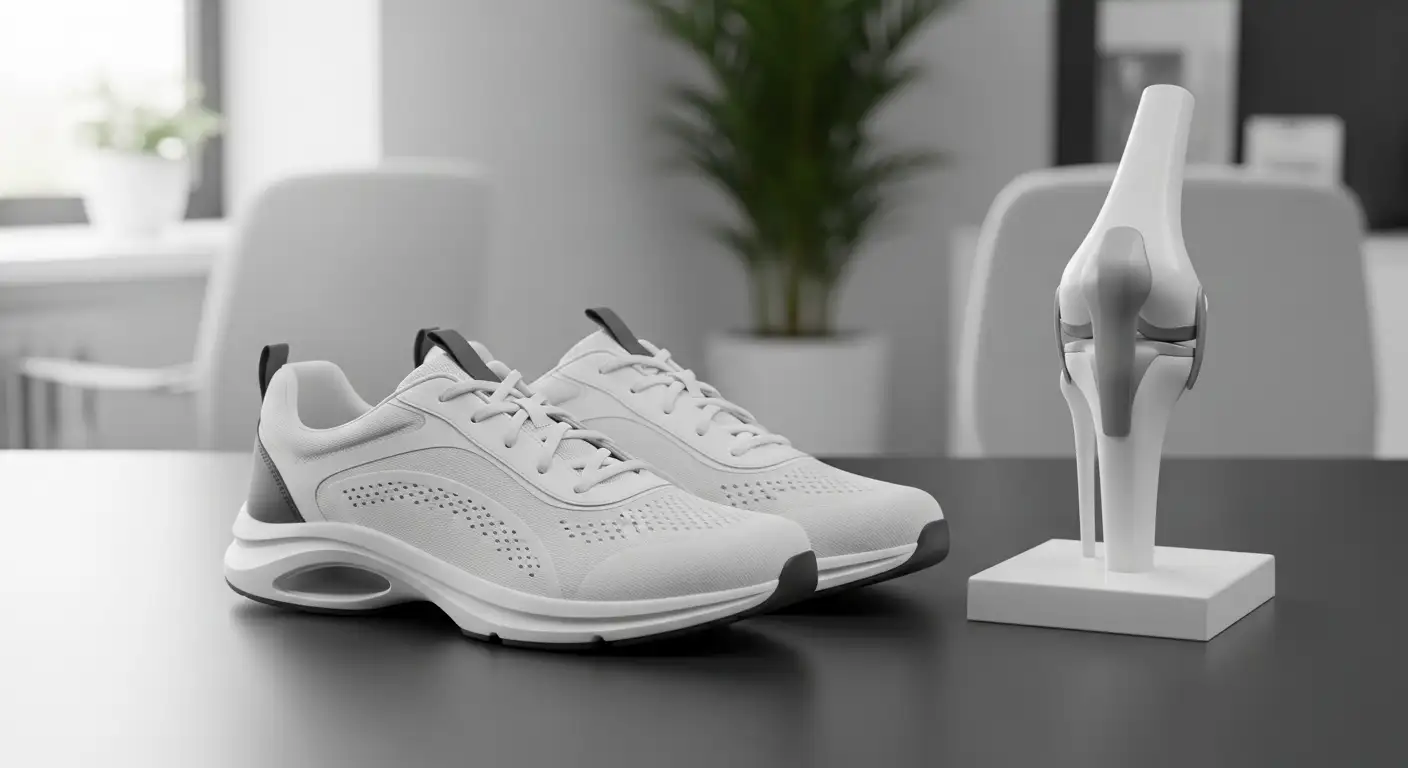The Challenge of Locked Knees
Locked knees can dramatically reduce mobility and quality of life, often signaling underlying joint issues such as osteoarthritis or injury. This article explores the nature of locked knees, their relationship with knee osteoarthritis, and contemporary medical treatments that can alleviate symptoms and restore movement. From the mechanics of true and pseudo locked knees to cutting-edge therapies, we delve into comprehensive management approaches tailored for those suffering from this disabling condition.
What is a Locked Knee? Differentiating True and Pseudo Locked Knees

Definition and Symptoms of Locked Knee
A locked knee occurs when a person cannot fully bend or straighten their knee. This condition often involves pain, swelling, stiffness, and sometimes a feeling of the knee catching or locking in place. People may experience popping or grinding noises and sometimes a bump around the joint. The inability to move the knee normally can severely impact daily activities.
Distinction Between True and Pseudo Locked Knees
Locked knees are categorized into two types: true locked knee and pseudo locked knee. True locked knee happens when there is an actual mechanical blockage inside the joint that physically prevents movement. In contrast, pseudo locked knee is caused by muscle spasms and pain that restrict movement without an actual physical obstruction.
Causes of Each Type
True locked knee is commonly caused by torn meniscus fragments lodged in the joint, loose bodies like cartilage or bone fragments, or other physical obstructions such as bone spurs from osteoarthritis. These blockages directly prevent knee motion.
Pseudo locked knee results from severe pain triggering muscle spasms around the knee joint. It is frequently linked to inflammation disorders such as osteoarthritis, plica syndrome (inflammation of a knee fold), patellar dislocation, or injury. Unlike true locking, the movement restriction stems from pain and muscle tightness, not a physical joint block.
Understanding these differences is crucial for diagnosis and treatment, as true locked knees may require surgical intervention to remove blockages, while pseudo locked knees often respond to pain management and physical therapy.
Knee Osteoarthritis: The Degenerative Force Behind Knee Locking
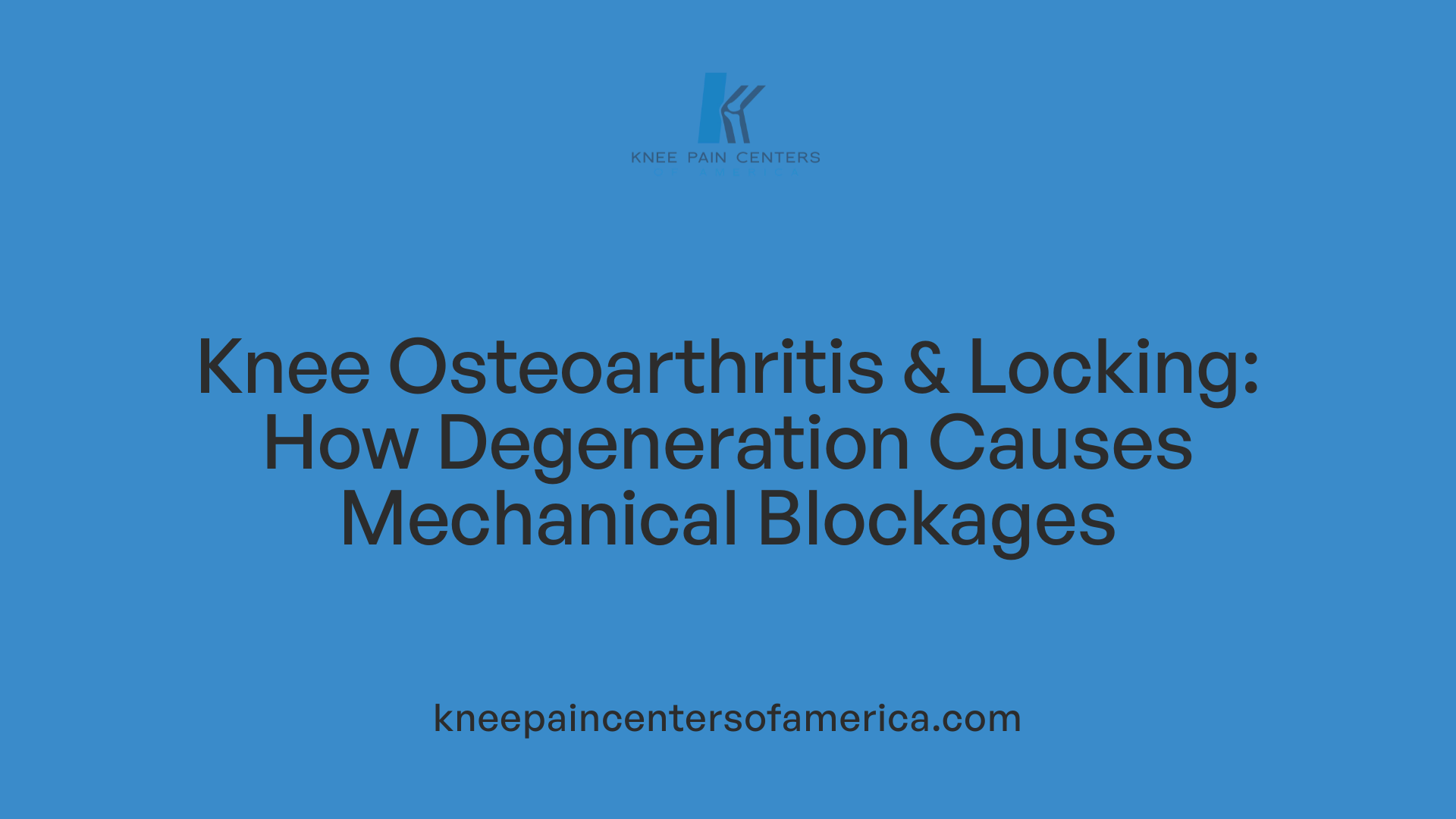
Nature and progression of knee osteoarthritis
Knee osteoarthritis is a degenerative joint disease characterized by the gradual breakdown of cartilage that cushions the knee joint. Over time, this cartilage wears away, leading to increased friction as bones rub directly against each other. The condition is progressive and lifelong, with stages ranging from minor cartilage wear (Stage 1) to severe cartilage loss and bone-on-bone contact (Stage 4). This progression contributes to worsening pain, stiffness, swelling, and decreased joint mobility.
How osteoarthritis causes locking
As osteoarthritis advances, the damaged joint undergoes structural changes, including the formation of bone spurs (osteophytes) and loose fragments of cartilage or bone within the joint. These physical obstructions can interfere with normal knee movement and cause a condition known as true locked knee, where the knee cannot fully bend or straighten. In addition to mechanical blockage, inflammation and tissue changes can lead to muscle spasms and pseudo-locking, further restricting knee motion.
Symptoms and complications related to knee osteoarthritis
The symptoms of knee osteoarthritis often develop gradually and include pain that worsens with activity, stiffness especially after periods of rest, swelling, a cracking or grinding sensation called crepitus, and feelings of instability or wobbliness in the knee. Locking or catching episodes are common and may signal underlying mechanical blockages. Complications from knee osteoarthritis can extend beyond joint discomfort, such as joint instability, the development of Baker’s cysts, and bone spurs. Moreover, the chronic pain and functional limitations may contribute to mood disorders like depression.
How does knee osteoarthritis contribute to locking and pain?
Knee osteoarthritis leads to cartilage deterioration causing bones to rub together and generate pain, swelling, and stiffness. Structural changes including bone spurs and loose cartilage fragments can physically obstruct knee movement, leading to true locked knee. Symptoms associated with this include pain intensifying with activity, stiffness, swelling, a cracking sensation, instability, and episodes where the knee catches or locks, significantly impacting quality of life.
Diagnosing Locked Knees and Osteoarthritis: Tools and Techniques
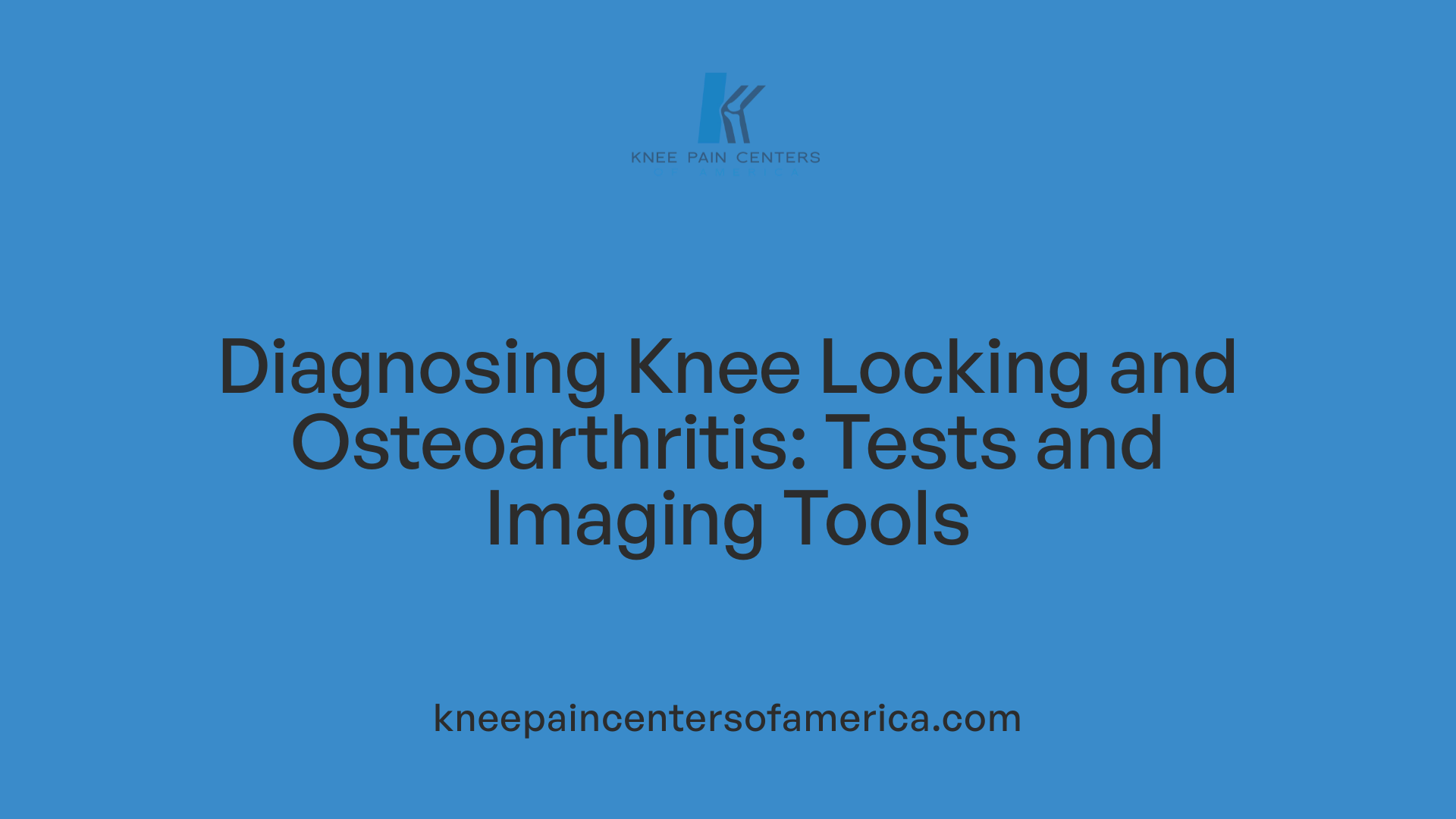
Physical examination and patient history
Diagnosing knee issues such as locked knees and osteoarthritis begins with a thorough physical examination and patient history. Doctors assess symptoms like pain, stiffness, swelling, and mobility limitations. They observe the knee's range of motion, evaluate joint stability, and check for signs such as cracking noises or locking sensations. Taking a detailed patient history helps identify risk factors including previous injuries, repetitive stress, weight, and family history that may contribute to knee problems.
Role of imaging like X-rays, MRI, CT scans, ultrasound
Imaging tests play a crucial role in confirming diagnoses and understanding the extent of joint damage. X-rays are commonly used to detect joint space narrowing, bone spurs, or deformities associated with osteoarthritis. MRI is more sensitive for visualizing soft tissues including cartilage, menisci, ligaments, and identifying causes of true locked knee such as meniscal tears or loose bodies blocking knee motion. CT scans and ultrasounds also assist in detailed assessment when needed, especially for complex cases or detection of cysts and inflammation.
Diagnostic challenges distinguishing types of knee locking
Differentiating between pseudo locked knee and true locked knee presents diagnostic challenges. Pseudo locked knee involves muscle spasms and pain without actual joint obstruction, often seen in inflammatory conditions like osteoarthritis or plica syndrome. In contrast, true locked knee is caused by mechanical blockages such as displaced meniscus fragments or loose cartilage pieces. Accurate diagnosis relies on correlating clinical findings with imaging results. Sometimes invasive methods like arthroscopy are required for definitive diagnosis and treatment planning.
Medical Treatments for Knee Pain and Osteoarthritis: From Conservative to Surgical
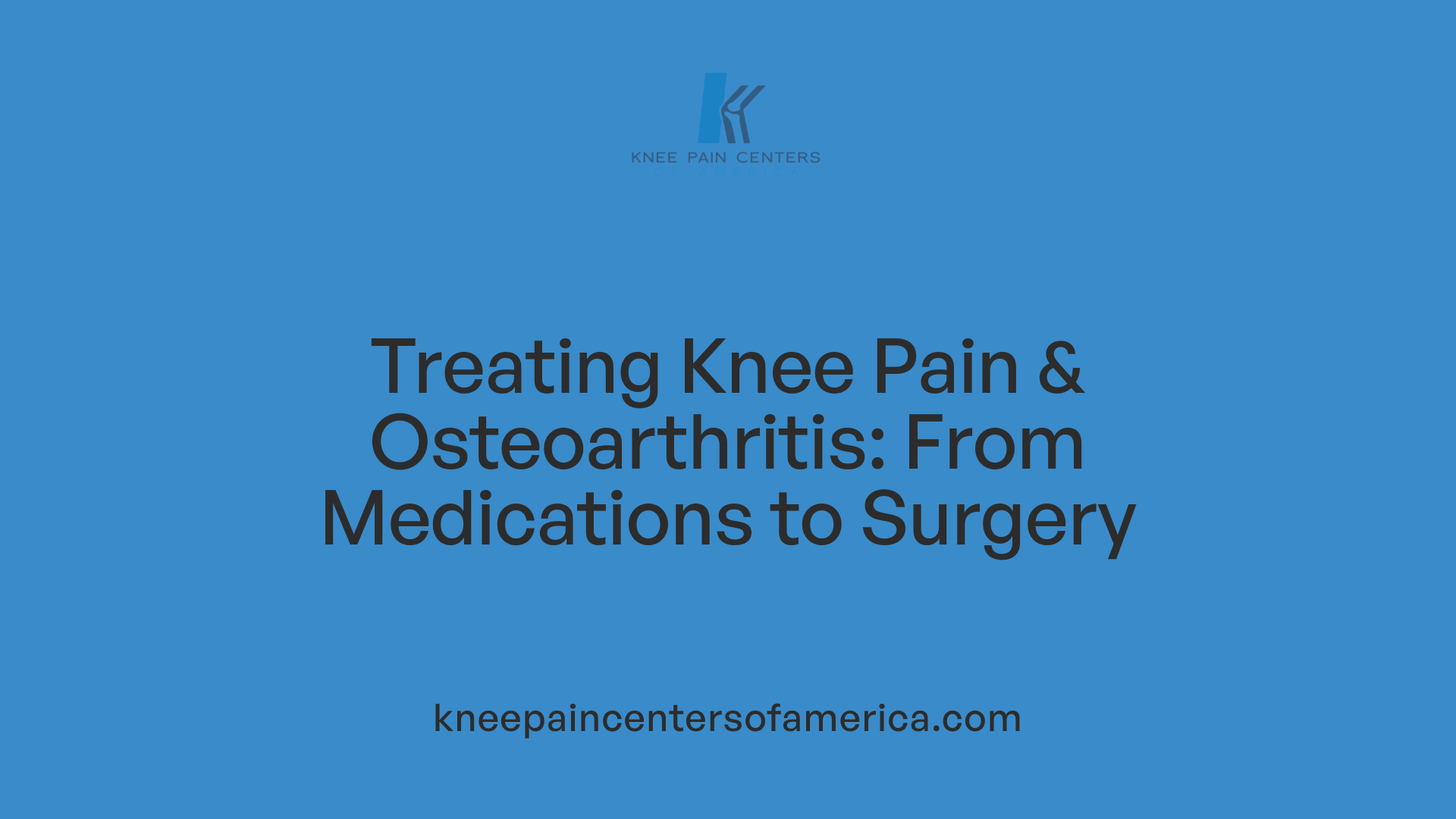
What are the common medical treatments available for knee pain and osteoarthritis?
Medical management of knee pain and osteoarthritis spans a range of conservative to surgical options tailored to symptom severity and patient needs.
Non-pharmacologic treatments such as physical therapy and weight management
Physical therapy plays a central role in managing knee osteoarthritis by strengthening muscles, improving flexibility, and stabilizing the knee joint. Tailored exercises—including hamstring curls, knee extensions, and mini squats—help reduce pain and improve function. Weight loss is highly recommended for overweight individuals, as reducing body mass lessens stress on the knee joint, slowing progression and alleviating symptoms. Additionally, lifestyle adjustments like low-impact activities (e.g., swimming, biking) and supportive orthotics complement therapy.
Pharmacologic options including NSAIDs and corticosteroid injections
For symptom relief, medications such as acetaminophen and nonsteroidal anti-inflammatory drugs (NSAIDs) are common first-line treatments. Topical creams and oral NSAIDs reduce inflammation and pain. Corticosteroid injections provide potent, targeted relief during flare-ups by reducing joint inflammation. Other injectable options include hyaluronic acid to improve joint lubrication and platelet-rich plasma (PRP) therapies, which are experimental but may aid cartilage healing. Supplements like glucosamine and chondroitin are sometimes used, though evidence on efficacy varies.
Surgical interventions including arthroscopy, osteotomy, and knee replacement
When conservative approaches are insufficient, surgical options are considered. Arthroscopy can remove loose cartilage or meniscal fragments causing mechanical symptoms such as locking. Osteotomy realigns the knee to redistribute weight away from damaged cartilage, suitable in earlier osteoarthritis stages. For advanced degeneration, partial or total knee replacement (arthroplasty) effectively restores joint function and relieves pain. These procedures have evolved to improve outcomes and reduce recovery time.
Supportive measures complementing medical treatments
Use of braces, compression sleeves, and heat or cold therapy further supports symptom control and mobility. Walking aids and activity modifications reduce joint load, aiding in daily functioning.
In summary, managing knee pain and osteoarthritis involves a comprehensive approach that includes physical therapy and weight management, medications to control inflammation and pain, and surgical interventions for advanced cases. Selecting appropriate treatments is individualized, aiming to maximize mobility and quality of life.
Physical Therapy: Cornerstone of Managing Knee Osteoarthritis and Locked Knees
What role does physical therapy play in the treatment of knee osteoarthritis?
Physical therapy is a fundamental part of managing knee osteoarthritis and locked knee conditions. It aims to reduce pain, swelling, and stiffness while improving knee mobility and overall joint function. By strengthening the muscles around the knee—such as the quadriceps and hamstrings—physical therapy helps stabilize the joint and reduces pressure on the damaged cartilage.
Types of exercises used to strengthen knee muscles
Common exercises include:
- Straight leg raises: Strengthen the quadriceps without putting strain on the knee.
- Hamstring curls: Target the back of the thigh, helping balance muscle support.
- Heel slides: Improve range of motion by gently bending and straightening the knee.
- Mini squats: Enhance thigh muscle strength and knee stability.
- Hamstring stretches: Increase flexibility to reduce tension around the knee.
These exercises are often tailored by therapists to accommodate symptom severity and individual needs.
Use of bracing, activity modifications, heat/cold therapy
Physical therapy also entails:
- Bracing: Provides joint support to reduce instability and pain.
- Activity modifications: Replacing high-impact activities with low-impact options like swimming or cycling to reduce joint stress.
- Heat and cold therapy: Heat can relax muscles and improve circulation, while cold therapy reduces inflammation and swelling.
Together, these measures help manage symptoms effectively.
Benefits in delaying or preventing surgery
Consistent physical therapy can slow the progression of osteoarthritis and reduce episodes of knee locking, delaying or even preventing the need for surgical intervention such as knee replacement or arthroscopy. Enhancing muscle strength and joint flexibility increases knee function, improves stability, and contributes to a better quality of life.
In summary, physical therapy is a comprehensive approach that combines exercise, supportive devices, and therapeutic modalities to manage knee osteoarthritis and locking symptoms. It empowers patients to maintain mobility and reduce pain while minimizing the reliance on surgery.
Corticosteroid Injections and Other Emerging Therapies: Pros, Cons, and Innovations
How effective are corticosteroid injections in managing knee osteoarthritis pain?
Corticosteroid injections are widely used for short-term relief of knee osteoarthritis pain. They can reduce inflammation and improve function notably within the first six weeks post-injection. However, their benefits tend to diminish over time, and by 24 weeks, their effectiveness is comparable to other treatments such as hyaluronic acid injections or physiotherapy.
While providing symptomatic relief, corticosteroid injections carry some risks. Frequent injections may accelerate cartilage deterioration and potentially worsen joint health. Other associated risks include pain at the injection site and the possibility of infection. Therefore, these injections are best reserved for short-term symptom management rather than long-term treatment strategies.
Are there any emerging medical treatments for knee osteoarthritis currently being researched?
New and innovative therapies are being developed to address knee osteoarthritis more safely and effectively. Genicular artery embolization is a minimally invasive procedure that targets and blocks inflamed blood vessels around the knee joint to reduce pain and swelling. It can often be performed on an outpatient basis and has shown sustained benefits in reducing symptoms.
Another promising new approach is low-dose radiation therapy. This treatment delivers targeted radiation to reduce inflammation and pain in the joint, with minimal side effects. Early studies suggest it may delay the need for surgery and improve patients' quality of life.
Both genicular artery embolization and low-dose radiation therapy are still under clinical investigation to confirm their long-term safety and disease-modifying potential. These emerging options offer hope for patients seeking less invasive alternatives to traditional surgical or medication treatments.
| Therapy | Benefits | Risks/Limitations |
|---|---|---|
| Corticosteroid Injections | Quick pain relief, short-term function improvement | Possible cartilage damage, infection risk, pain post-injection |
| Genicular Artery Embolization | Minimally invasive, sustained pain reduction | Limited long-term data, procedural risks |
| Low-Dose Radiation Therapy | Non-surgical, minimal side effects, pain relief | Experimental, unclear long-term effects |
When Knee Replacement Surgery Becomes Necessary in Osteoarthritis Management
When is knee replacement surgery considered for osteoarthritis patients?
Knee replacement surgery is typically considered for osteoarthritis patients when conservative treatments no longer provide relief. These nonsurgical methods include physical therapy, pain medications, weight loss, and bracing. When symptoms—especially severe, persistent pain—continue to interfere with daily activities and quality of life despite these efforts, surgery is evaluated as an option.
Criteria for considering knee replacement
The decision to proceed with knee replacement depends on several factors:
- Severity of symptoms: Persistent pain that limits mobility and functional capacity.
- Extent of joint damage: Confirmed through imaging tests like X-rays or MRI showing severe cartilage loss and bone changes.
- Failed conservative treatments: Several months of ineffective nonsurgical management.
- Impact on quality of life: Including restriction in daily activities and sleep disturbances.
Risks and benefits of surgery
Knee replacement surgery generally offers significant pain relief and improved function, enhancing patients' mobility and life quality. However, as with any major operation, potential risks must be weighed:
| Benefits | Risks | Description |
|---|---|---|
| Pain reduction | Infection | Postoperative infections requiring antibiotics or further surgery |
| Improved joint function | Blood clots | Deep vein thrombosis or pulmonary embolism risk |
| Enhanced mobility | Implant loosening or failure | May require revision surgery after years |
| Better quality of life | Surgical complications | Including bleeding, nerve damage, and anesthesia risks |
Ultimately, knee replacement is recommended only when the potential benefits of pain relief and improved function outweigh these risks and after thorough patient evaluation.
Managing Locked Knees: A Multifaceted Approach
Locked knees present a complex challenge often rooted in degenerative conditions such as osteoarthritis or mechanical joint issues. Understanding the distinction between true and pseudo locked knees facilitates appropriate diagnosis and treatment selection. With a spectrum of medical treatments ranging from physical therapy and pharmacologic agents to innovative minimally invasive procedures and surgical interventions, patients have multiple avenues to restore mobility and reduce pain. Early intervention, lifestyle modifications, and adherence to therapeutic regimens are essential to delaying progression and improving quality of life. As research advances, emerging therapies hold promise to further enhance outcomes for those suffering from knee locking and related osteoarthritic complications.
References
- Knee Osteoarthritis: Symptoms, Stages, Causes & Treatment
- Locked knee: Causes, symptoms, and treatment
- Knee Arthritis
- Knee Locking: Causes and Treatments for Relief
- Knee Osteoarthritis: Early Signs, Causes, Diagnosis, ...
- Osteoarthritis of the Knee
- How to Unlock a Locked Knee – Causes and Treatment
- Knee pain: MedlinePlus Medical Encyclopedia
- Arthritis in Knee: Signs, Symptoms, Causes & Treatment
- Osteoarthritis Symptoms, Causes & Risk Factors | NIAMS

